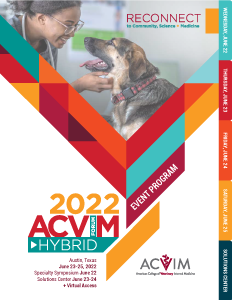Back
Please note, this session is not eligible for CE credit via on demand viewing. It is only available for CE credit if you attended the session live in person.
Research Abstract - Oral
Small Animal Internal Medicine
GI08 - Fecal pancreatitis-associated-protein-1 and Gastrotropin as Biomarkers for Subgroup Identification in Canine Chronic Enteropathies
Friday, June 24, 2022
10:00 AM – 10:15 AM CT
Location: ACC 17AB
CE: .25

Karin Allenspach, DVM, PhD, DECVIM
Professor of Internal Medicine and Translational Health
Iowa State University
Ames, Iowa, United States
Research Abstract - Oral Presenter(s)
Abstract: Non-invasive biomarkers to predict treatment responses in canine Chronic Enteropathies (CE) are urgently needed. In a recent exploratory proteomic study, several pancreatic/intestinal enzymes, acute phase proteins and immunoglobulins (Ig) were found to be differentially present in feces from healthy dogs and dogs with CE. In this follow-up study, we sought to evaluate the discriminatory ability of these biomarkers to predict subgroups of dogs with CE.
Fifty-eight dogs with CE were included in the study (25 food-responsive diarrhea (FRD), 12 antibiotic-responsive diarrhea (ARD), 10 steroid-responsive diarrhea (SRD), 11 chronic diarrhea of other causes). Spatial Proximity Analyte Reagent Capture Luminescence (SPARCLTM) assays were developed to measure the fecal concentrations of the following analytes: Pancreatitis-associated-protein-1 (PAP1), haptoglobin (HP), S100A8, IgG1, IgG2, IgGFc, alpha-1-acid glycoprotein (AGP), ceruloplasmin, C-reactive protein (CRP), intestinal fatty acid-binding protein (FABP), liver-FABP, and gastrotropin. Multivariate logistic regression was used to assess the predictive ability of analytes to differentiate between CE and chronic diarrhea of other causes, and between subgroups of CE.
Fecal levels of gastrotropin were predictive of CE vs. chronic diarrhea due to other causes. In addition, dogs with lower fecal HP and CRP were more likely to be FRD. Furthermore, higher fecal concentrations of PAP-1 were significantly associated with ARD. For SRD, higher CCECAI and weight loss, and higher fecal concentrations of IgG1, IgG2, CRP and gastrotropin were identified as markers with predictive ability.
In conclusion, this study suggests that novel fecal biomarkers PAP-1 and gastrotropin could be predictive of ARD and SRD, respectively, in dogs with CE.
Fifty-eight dogs with CE were included in the study (25 food-responsive diarrhea (FRD), 12 antibiotic-responsive diarrhea (ARD), 10 steroid-responsive diarrhea (SRD), 11 chronic diarrhea of other causes). Spatial Proximity Analyte Reagent Capture Luminescence (SPARCLTM) assays were developed to measure the fecal concentrations of the following analytes: Pancreatitis-associated-protein-1 (PAP1), haptoglobin (HP), S100A8, IgG1, IgG2, IgGFc, alpha-1-acid glycoprotein (AGP), ceruloplasmin, C-reactive protein (CRP), intestinal fatty acid-binding protein (FABP), liver-FABP, and gastrotropin. Multivariate logistic regression was used to assess the predictive ability of analytes to differentiate between CE and chronic diarrhea of other causes, and between subgroups of CE.
Fecal levels of gastrotropin were predictive of CE vs. chronic diarrhea due to other causes. In addition, dogs with lower fecal HP and CRP were more likely to be FRD. Furthermore, higher fecal concentrations of PAP-1 were significantly associated with ARD. For SRD, higher CCECAI and weight loss, and higher fecal concentrations of IgG1, IgG2, CRP and gastrotropin were identified as markers with predictive ability.
In conclusion, this study suggests that novel fecal biomarkers PAP-1 and gastrotropin could be predictive of ARD and SRD, respectively, in dogs with CE.

